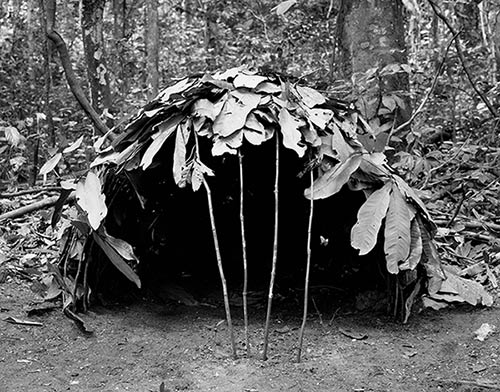In my photographic work, I deal with the conditions of human existence. The pictures are taken in different places inside and outside Europe, with a focus on rural African societies characterised by pastoralist culture. One of the resulting series, which I have been continuously developing for two decades, is Self-Contained, a project that deals with African vernacular architecture.
My works fit into different frames of observation. On the one hand, it is the view of the outsider, as I am in a society that is foreign to me. On the other hand, the superordinate framework plays a defining role: in this case, architecture. The pictures were taken in Sudan, South Sudan, Chad, Ethiopia, Uganda, Kenya, Tanzania, Cameroon and the Central African Republic.
Looking at settlements from a distance has awakened my interest in vernacular architecture: Which structures enable their inhabitants to lead a life far away from the urban infrastructure and in sometimes extreme climatic conditions? The living spaces and other structures – fences, food stores and stables – have one thing in common: they are essentially made of materials that are available locally. How these buildings are erected is passed on from generation to generation as shared knowledge. Vernacular architecture means architecture without architects. The constructions are an expression of a traditionally efficient and at the same time forward-looking way of life in dealing with resources: the renunciation of everything superfluous.
I took the pictures in the settlements of the pastoralists, some – such as pictures of stables or overviews – also outside. The series includes tents of nomadic peoples such as the Afar, the Beja and the Somali, as well as buildings in permanent settlements such as those of the Toposa, the Lotuko and the Dizi. I have visited most of these places several times over the years. In Self-Contained, I therefore also deal with the interim developments and the disappearance of structures of vernacular architecture.
I use an analogue large-format camera for the series. It allows me to work precisely and to involve the owners in the shooting process, as the final image is clearly visible on the camera’s large screen. All photographs of inhabited premises were taken in the company of the respective owners. An integral part of my working method is a longer stay on location, because the time of day, which brings with it a specific shadow cast, is important for the timing of the shot. I observe the course of the shadow throughout the day before deciding on the right moment.
One of the basic conditions of pastoral society is the ability to survive in different, sometimes extremely arid climate zones through mobility and adaptation. The regions where I photograph are particularly affected by climate change, and have been for a long time. In recent years, for example, Sudan, South Sudan and parts of Ethiopia have seen an increase in hot and dry spells, heavy rainfall with flooding and shifts in the rainy season. Climate change determines the movement behaviour of people in the affected rural regions; conflicts between neighbouring peoples increase when groups encroach on foreign territories. This is reflected in the series of images. It includes, for example, dilapidated buildings belonging to the Borana and the Toubou, who have left their territory due to the drought, and buildings belonging to a Toposa group that is on the run. At the same time, peoples such as the Gabbra or the Rendille are adapting their tents to the changed conditions by integrating plastics into their dwellings. These materials protect the interior from penetrating wind, sand and water.
As the way of life changes, traditional forms of architecture are also being lost. If the buildings made of wooden sticks, grass or clay are not continuously repaired and renewed, they disappear.
The vernacular architecture of Africa is a subject that was severely neglected during the colonial era. The Europeans brought their own architectural language with them. The introduction of materials such as concrete and iron influenced not only the physical structure of the buildings, but also the cultural identity of the peoples. The dominance of European architecture, especially in the cities, continued after the end of the colonial era, and traditional building methods were often considered outdated. Countering this tendency with a different perspective is a central aspect of the work.



